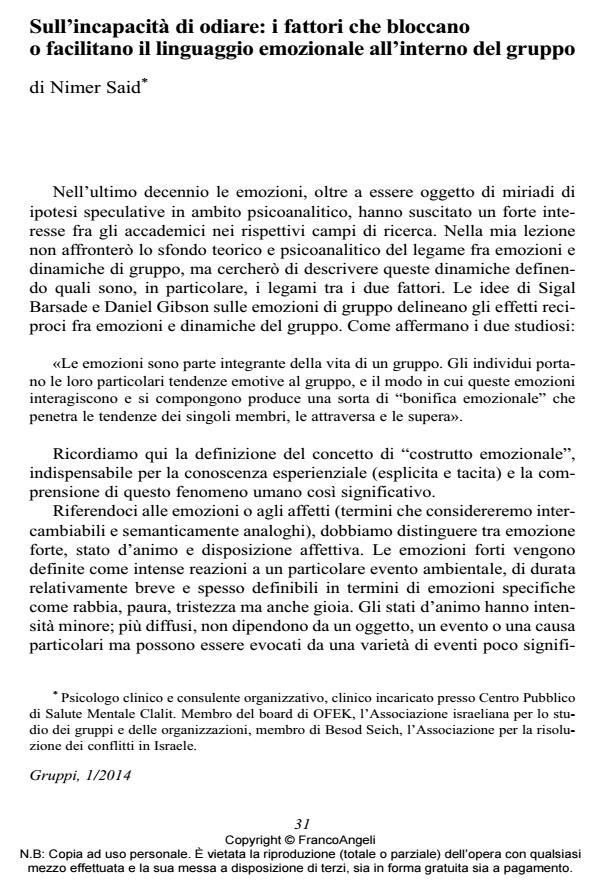Sull’incapacità di odiare: i fattori che bloccano o facilitano il linguaggio emozionale all’interno del gruppo
Titolo Rivista GRUPPI
Autori/Curatori Nimer Said
Anno di pubblicazione 2014 Fascicolo 2014/1
Lingua Italiano Numero pagine 6 P. 31-36 Dimensione file 64 KB
DOI 10.3280/GRU2014-001004
Il DOI è il codice a barre della proprietà intellettuale: per saperne di più
clicca qui
Qui sotto puoi vedere in anteprima la prima pagina di questo articolo.
Se questo articolo ti interessa, lo puoi acquistare (e scaricare in formato pdf) seguendo le facili indicazioni per acquistare il download credit. Acquista Download Credits per scaricare questo Articolo in formato PDF

FrancoAngeli è membro della Publishers International Linking Association, Inc (PILA)associazione indipendente e non profit per facilitare (attraverso i servizi tecnologici implementati da CrossRef.org) l’accesso degli studiosi ai contenuti digitali nelle pubblicazioni professionali e scientifiche
Se le emozioni sono parte integrante della vita di un gruppo e gli individui portano le loro particolari tendenze emotive al gruppo, il modo in cui queste emozioni interagiscono e si compongono può produrre una sorta di "bonifica emozionale" che penetra le tendenze dei singoli membri, le attraversa e le supera. Nell’approccio che definiamo top-down il gruppo viene considerato come un tutto e i conduttori del gruppo cercano di catturare le dimensioni dell’elusivo sentimento che sorge dalle dinamiche del gruppo, focalizzandosi sul gruppo come entità olistica che influenza i sentimenti e i comportamenti dei membri. Nell’approccio bottom-up le emozioni del gruppo sono invece viste come somma delle sue parti, vagliando il modo in cui le emozioni dei singoli membri si combinano insieme creando un’emozione a livello di gruppo. Il gruppo che viene presentato appartiene al lavoro dei servizi psichiatrici di una città mista della Galilea. Era composto di 12 membri: 8 uomini (4 arabi e 4 ebrei) e 4 donne (2 arabe e 2 ebree). Il gruppo, che ha lavorato per un anno e mezzo, cercava di sostenere individui che soffrivano di disagi sociali per cause principalmente relazionali e le cui diagnosi psichiatriche andavano da moderati disturbi affettivi e d’ansia a disturbi d’adattamento. Nella discussione affrontata dallo staff prima di formare il gruppo ci si interrogava soprattutto sulla capacità e la disponibilità dei pazienti di nazionalità araba a prendere parte a questo genere di terapia di gruppo, visto che precedenti esperienze avevano rivelato la riluttanza dei pazienti arabi a prendere parte a questo tipo di aiuto professionale e ci si domandava se la terapia di gruppo potesse essere benefica per i sintomi clinici nel caso di pazienti di nazionalità differenti, con conflitti e tensioni bi-nazionali. Descrivendo il percorso del gruppo, si rileva come nell’ultimo periodo vi sia stata una maggiore elaborazione da parte dei partecipanti delle differenze ed eterogeneità fra le emozioni e, parallelamente, sentimenti attivi, negativi e diretti come la rabbia, il risentimento e persino l’odio abbiano avuto maggiore espressione e, addirittura, un maggiore contenimento.
Parole chiave:Gruppo, emozione, disposizione affettiva, approccio top-down, approccio bottom-up, contagio emotivo.
Nimer Said, Sull’incapacità di odiare: i fattori che bloccano o facilitano il linguaggio emozionale all’interno del gruppo in "GRUPPI" 1/2014, pp 31-36, DOI: 10.3280/GRU2014-001004